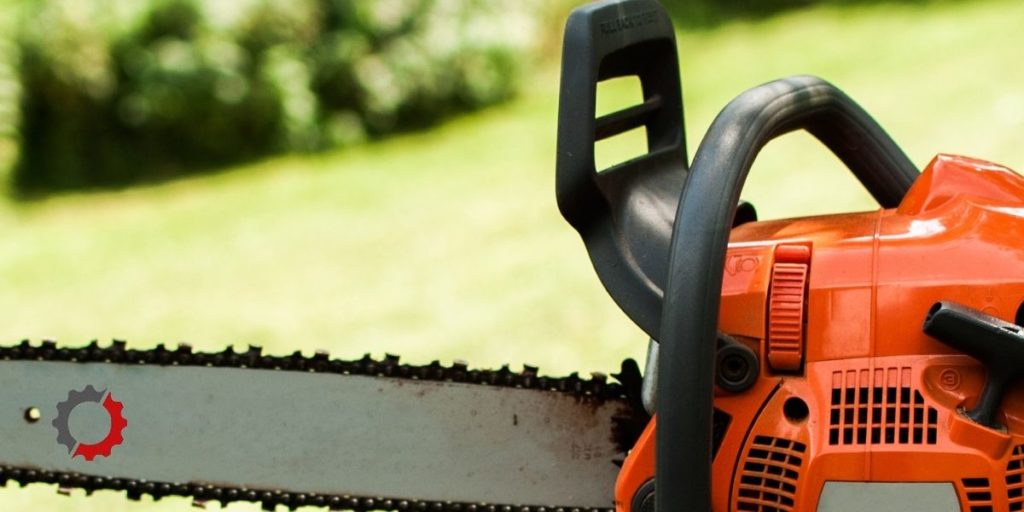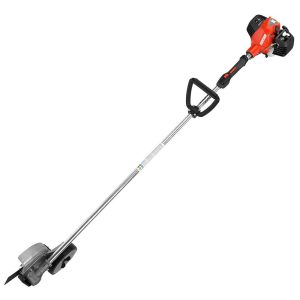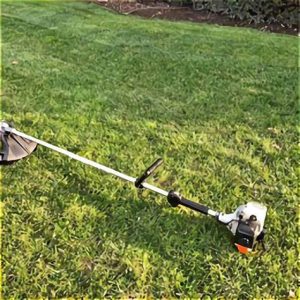Your Husqvarna Chainsaw Starts, Stalls & Dies (FIX IT!)
It’s frustrating when a chainsaw just stops running. How are you going to cut down a tree or remove debris from the last big storm? Start by ensuring your saw has a good fuel filter, air filter, and spark plug, and then continue to check the other components that can cause a chainsaw to die.
A Husqvarna chainsaw starts and then dies when it isn’t getting the air, fuel, or spark it requires because of a wrong choke setting; plugged air or fuel filter; clogged fuel line; bad fuel tank vent; plugged spark arrestor; dirty carburetor; faulty ignition coil; or plugged cooling system.
Keep reading for additional reasons a chainsaw will quit. Never perform repairs on a chainsaw without removing the spark plug wire, waiting for the engine and muffler to cool, and waiting for all parts to stop moving.

This post may include affiliate links. Purchases made through these links may provide a commission for us, at no extra cost to you. As an Amazon Associate, we earn from qualifying purchases.
Follow all safety instructions provided in your equipment operator’s manual prior to diagnosing, repairing, or operating.Consult a professional if you don’t have the skills, or knowledge or are not in the condition to perform the repair safely.
Table of Contents
13 Reasons Your Husqvarna Chainsaw Starts Then Dies
Incorrect Choke Setting on a Husqvarna Chainsaw
The choke is used to restrict air to the engine to allow the cylinder to receive more fuel when starting a cold engine. Once the engine gets warm, the choke needs to be moved to the off position to allow airflow so the engine continues to run.
If you don’t disengage the choke once the chainsaw starts and the engine is warm, it will die because the engine isn’t getting enough air to keep running.
Plugged Air Filter on a Husqvarna Chainsaw
The air filter is a maintenance part on your Husqvarna chainsaw that must be kept clean and in good condition. Its purpose is to keep dirt from entering the carburetor throat and wearing on the engine.
It’s best to replace the air filter annually for the average homeowner and inspect it frequently throughout the year to clean or replace it if necessary.
When filter maintenance is skipped, the filter can become plugged with dirt, sawdust, and debris. The buildup can be significant enough to reduce airflow through the filter. When this happens, the chainsaw will stall and die.
Clean a Husqvarna chainsaw air filter:
- Remove the engine cover.
- Remove the air filter.
- Wipe out any dirt from the air filter housing.
- Brush dirt from the filter or shake it to remove the dirt.
- If needed, wash it in a mild dish detergent and water solution, rinse until the water runs clear, and allow the filter to completely dry.
- Reinstall the clean filter. Purchase and install a new air filter if the old filter is extremely dirty, damaged, or is unable to seal properly.
Plugged Cooling System on a Husqvarna Chainsaw
The cooling system must be kept clean to keep the engine from getting too hot, overheating, and shutting down. To help cool the engine, remove dirt and debris that block the air intake and cooling fins.
To do this, first, remove the spark plug and wait for the engine to cool. Remove the engine cover and remove debris from the cover and around the outside of the cylinder.
Clean the cylinder cooling fins, the pawls on the flywheel, and other areas air moves through the chainsaw. Reinstall the engine cover. Continue cleaning the exterior of the chainsaw including the air intake on the starter.
Plugged Spark Arrestor on a Husqvarna Chainsaw
You will find a small metal screen off the muffler on many Husqvarna chainsaws. The screen keeps hot exhaust material from shooting out of the chainsaw.
This small screen is subject to carbon buildup that can reduce airflow and cause a Husqvarna chainsaw to die.
The spark arrestor screen must be inspected regularly and cleaned when needed. Begin by removing the spark plug wire and allow the muffler to cool. Then remove the spark arrestor screen on the muffler
Clean the screen with a metal brush. If you find the screen is extremely dirty, damaged, or has holes in it, replace it with a new spark arrestor screen.
To minimize carbon building up on the spark arrestor quickly, make sure you periodically run your chainsaw at full throttle. Letting your chainsaw idle or run at low speeds for a long time will contribute to a buildup of carbon.
Old Fuel in a Husqvarna Chainsaw
Fuel can be the biggest culprit when it comes to a chainsaw not running well and dying. Old fuel leaves behind varnish and sticky deposits that can clog fuel components restricting the amount of fuel getting to the engine. This can cause the saw to shut off.
To reduce the negative effects of fuel on your Husqvarna, always use fresh fuel with a low ethanol content. Make sure the fuel is made up of gasoline and oil mixed at a ratio of 50:1.
Here are a few tips for selecting and caring for fuel:
- Only use fresh fuel. Fuel can begin to degrade as quickly as 30 days after purchase.
- Use a 50:1 gas-to-oil mixture in your 2-cycle Husqvarna chainsaw.
- Select gasoline with a minimum octane rating of 89 and a maximum ethanol content of 10%.
- Mix in a premium 2-cycle oil that is ISO-L-EGD and JASO M345 FD certified.
- Add a fuel stabilizer. To prevent gas from breaking down so it lasts a little longer, add a fuel stabilizer like Sea Foam or STA-BIL. These products will reduce moisture and clean the fuel system as well. Some 2-cycle oils include a stabilizer, but you’ll have to determine how long the stabilizer is effective as it can vary from 30 days to 2 years.
Read more about fuel selection and care in “This is the Type of Gas and Oil Husqvarna Chainsaws Use“.
Plugged Fuel Filter in a Husqvarna Chainsaw
The fuel filter’s function is to keep dirt from entering the fuel system and damaging the engine. The fuel filter is a small cylinder-shaped part located inside the fuel tank.
You will find it attached to the fuel line. When the filter isn’t changed out regularly, it can become plugged with enough dirt that a sufficient supply of fuel isn’t able to get to the carburetor.
Inspect the filter and replace it if needed. I like to replace it annually and more often if I begin using it regularly.
I use my saw a lot during the winter and not too much the rest of the year. I typically change the fuel filter before and after the winter season.
Change a Husqvarna chainsaw fuel filter:
- First, wipe around the fuel tank cap so dirt doesn’t fall into the tank.
- Pull the filter out of the tank using a filter hook or a clean bent wire.
- Once the filter is out of the tank, grab the fuel line with one hand and pull the filter out of the line with the other hand. Don’t lose the ring clip. Keep the clip in the fuel line.
- Insert a new fuel filter into the line and secure the line to the filter with the ring clip.
- Place the fuel filter inside the tank.
- Reinstall the fuel cap.
Clogged or Punctured Fuel Line on a Husqvarna Chainsaw
Gummy deposits left behind by old fuel can clog the fuel line restricting fuel flow. When you find a clogged fuel line, remove it from the chainsaw and clean it to open the line.
Spray carburetor cleaner into the line to loosen the clog. Follow this with compressed air to dislodge and remove the clog. Repeat as necessary to remove the clog.
If you can’t remove the clog or you find the fuel line is dry and cracked, you need to replace the fuel line with a new line of the same diameter and length.
Also, replace any line that has a puncture. A punctured fuel line can draw air into the fuel system resulting in a chainsaw running sluggish because too much air is being introduced to the cylinder.
Plugged Fuel Tank Vent on a Husqvarna Chainsaw
The fuel tank on a Husqvarna chainsaw must be able to vent to allow air to pass in and out of the tank.
Air must be able to pass through the vent and out of the tank when fuel is added. Air also needs to be able to pass into the tank when the fuel level decreases.
When the tank isn’t able to vent, pressure builds, and a vacuum forms that will prevent fuel from leaving the tank to the carburetor.
Locate the fuel vent on your Husqvarna chainsaw and replace a clogged vent. It is a small circular part that is installed on the top side of the tank.
Dirty Carburetor on a Husqvarna Chainsaw
The carburetor mixes the correct proportion of air and fuel required for your Husqvarna chainsaw to start and continue to run. The passageways can become clogged and the small components can fail to function correctly which can be the reason the chainsaw stops running.
Old fuel is a big reason why a Husqvarna carburetor will stop working. You may be able to clean or rebuild your carburetor to get it working again. You will have to replace the carburetor if this doesn’t work.
Carburetor Needs Adjustment on a Husqvarna Chainsaw
The carburetor may need to be adjusted to change the RPMs at idle speed and at full throttle. There are adjustment screws on the carburetor to make these adjustments.
The screws are labeled “L” for low speed and “H” for high speed. Let the chainsaw idle and adjust the low-speed screw clockwise and counter-clockwise until you find the “sweet spot” where it runs smoothly and not sluggish.
Next, adjust the “H” to get a good smooth RPM at full throttle. Don’t over-adjust and allow the RPMs to increase too much or you will damage the engine.
Husqvarna does have some limits to the adjustments you can perform to the carburetor. If you are continuing to have problems with the carburetor or your model Husqvarna doesn’t allow you to make the carburetor adjustments, bring your chainsaw to your local Husqvarna dealer.
A special tool may be required so only your dealer can make the necessary adjustments.
Bad Spark Plug on a Husqvarna Chainsaw
A dirty or broken spark plug won’t provide the consistent spark needed to run the chainsaw. It may provide intermittent spark causing the saw to lose power and possibly die.
Inspect the condition of the spark plug tip. If it is very dark in color, has a broken porcelain or burnt electrode, the spark plug must be replaced.
You can try to clean the spark plug with a wire brush and reuse it if it’s just a little dirty. I prefer to just replace it. It’s an important part required for your Husqvarna to run well and it’s an inexpensive maintenance part.
Make sure the spark plug is gapped correctly and the spark plug wire is securely attached. (Don’t leave the spark plug attached if you need to continue to make additional repairs).
Faulty Ignition Coil on a Husqvarna Chainsaw
After you have confirmed the spark plug is in good condition, check the ignition coil to make sure it is functioning correctly. The coil provides the electrical current to the spark plug to form a spark that ignites the fuel to start and keep your chainsaw running.
When the coil gets hot, the winding on the coil can separate and short out. This will cause your Husqvarna chainsaw to lose power, run sluggishly or stop running when there is an intermittent spark.
A bad ignition coil will not be able to provide sufficient voltage to the spark plug.
Compression Problem with a Husqvarna Chainsaw Engine
While pulling the starter recoil rope, you may notice a loss of compression. When the compression is low on a Husqvarna chainsaw, it will fail to have enough pressure which can cause it to quit running.
This can be the result of worn crankshaft seals, worn piston rings, or damage to the piston.
I advise bringing your chainsaw to a small engine mechanic or your Husqvarna dealership for testing and making necessary repairs.







